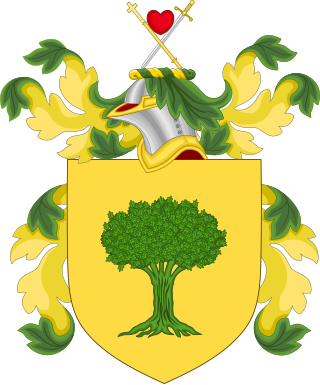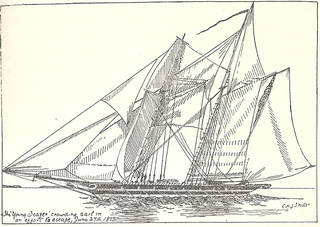
Thomas Boyle, an Irish American, as a captain of the schooner Comet and the clipper Chasseur, was one of the most successful Baltimore privateers during the War of 1812. He briefly served in the United States Navy during the same war.
USS Gallatin was a post-Revolutionary War sailing vessel that the U.S. Department of the Treasury purchased at Norfolk, Virginia, for the United States Revenue-Marine in December 1807. An explosion on board destroyed her in 1813.

Young Teazer was a United States privateer schooner that captured 12 British vessels, five of which made it to American ports. A member of her crew blew her up at Mahone Bay, Nova Scotia during the War of 1812 after a series of British warships chased her and after HMS Hogue trapped her. The schooner became famous for this deadly explosion, which killed most of her crew, and for the folklore about the ghostly "Teazer Light."
HMS Highflyer was originally an American privateer schooner built in 1811. As a privateer she took several British vessels as prizes. The Royal Navy captured her in 1813. She then participated in several raids on the Chesapeake and coastal Virginia before the Americans recaptured her later in 1813.

HMS St Lawrence was a 14-gun schooner of the Royal Navy. She had been built in 1808 in St. Michaels, Talbot County, Maryland for Thomas Tennant and sold to Philadelphians in 1810. During the War of 1812 she was the US privateer Atlas. The UK captured her in 1813 and renamed her St Lawrence. The US privateer Chasseur recaptured her in 1815, and then HMS Acasta re-recaptured her.
HMS Hermes was a 20-gun Hermes-class sixth-rate flush-decked sloop-of-war built in Milford Dockyard to the lines of the ex-French Bonne Citoyenne. She was destroyed in 1814 to prevent her falling into American hands after grounding during her unsuccessful attack on Fort Bowyer on Mobile Point outside Mobile, Alabama.
HMS Landrail was a Cuckoo-class schooner built by Thomas Sutton at Ringmore, Teignmouth. Like all her class she carried four 12-pounder carronades and had a crew of 20. She had a relatively uneventful career during the Napoleonic Wars and the War of 1812 until 1814 when she was taken in a notable action, and then retaken. She was sold in approximately 1818.
HMS Shelburne was the American letter of marque schooner Racer, built in Baltimore in 1811 and captured by the British in 1813. She served on the American coast, capturing the American brig Frolic. She also captured some merchantmen and was sold in Britain in 1817.

HMS Dolphin was the 12-gun American privateer schooner Dolphin that Admiral John Borlase Warren's squadron captured on 13 April 1813 and that the Royal Navy took into service. As HMS Dolphin she participated in boat actions on 29 April and 5 May 1813 for which the Admiralty issued a clasp for the Naval General Service Medal. Her ultimate fate is currently undocumented.

Rossie was a schooner launched at Baltimore in 1807. At the outbreak of the War of 1812 she became a privateer, operating under a letter of marque. She made two voyages, the first as a privateer, and the less successful second as a letter of marque. The British captured her in January 1813.
Tartar was an unsuccessful American privateer schooner during the War of 1812. She was launched in 1813 and was driven ashore and destroyed on her maiden voyage at the end of the year, not having captured anything.
Invincible Napoleon was a three-masted French privateer commissioned in Bayonne in Spring 1804. She made numerous cruises until 1813–1814 when the British and the Americans repeatedly captured her. In her brief career as an American privateer she captured some 14 vessels. She finally ended up in British hands and was taken to Halifax, Nova Scotia as a prize.

Comet, an American schooner, was built in 1810 at Baltimore, Maryland. She was owned by "a group of wealthy Baltimore investors." Under Captain Thomas Boyle, who was a part owner of the schooner, Comet sailed from July 1812 to March 1814 as a privateer, which was a type of ships licensed by the United States during the War of 1812 to harass the British merchant vessels and divest their cargoes.
Roe was launched in France in 1792, almost certainly under another name. The British captured her and between 1801 and 1808 she became a slave ship, making four voyages out of Liverpool. After the end of the British slave trade Roe traded with Brazil. The Americans captured her in 1812 but she was quickly recaptured. She was wrecked in November 1814.
Sarah Ann was a United States privateer commissioned at Baltimore in 1812. She captured a British merchantman in a single-ship action before HMS Rhodian captured Sarah Ann on 16 September 1812.
Star was launched in New York in 1812. She was captured in 1813 and first appears in the Register of Shipping (RS) in 1814. In 1815 she sailed to Batavia under a license from the British East India Company (EIC). On her way back a privateer from the United States captured her in a notable single-ship action and then sent her into New York.
Townshend Packet was launched at Falmouth in 1800 as a packet for the Post Office Packet Service. She made numerous voyages between Falmouth and Lisbon and also sailed to the West Indies, Brazil, and the Mediterranean. She had two engagements with American privateers. In the first the Americans captured her, but then released her. In the second she repelled her attacker. A French frigate captured her in 1814 and then sank her.
Lady Mary Pelham was launched in 1811 as a packet based in Falmouth, Cornwall for the Post Office Packet Service. She repelled attack by privateers in 1812 and 1813, the latter being a notable and controversial engagement with an American privateer. Another American privateer captured her in February 1815 in the West Indies. New owners retained her name and between 1815 and at least 1824 she continued to sail to the Continent and South America.
HMS Barbadoes was a 16-gun vessel, the American Herald, captured in 1813. The Royal Navy took her into service as HMS Barbadoes She captured a number of merchantmen and privateers before she was paid-off in May 1816. In 1814–1815 she also captured three Spanish and French vessels carrying over 1100 slaves. Barbadoes became a powder ship in Jamaica that was later wrecked with her remains being sold.
Hercules was launched at Bristol in 1796 as a West Indiaman. In 1815, a United States privateer captured her, but the Royal Navy recaptured her. Because the recapture occurred after 1 March 1815, she was returned to the United States.





